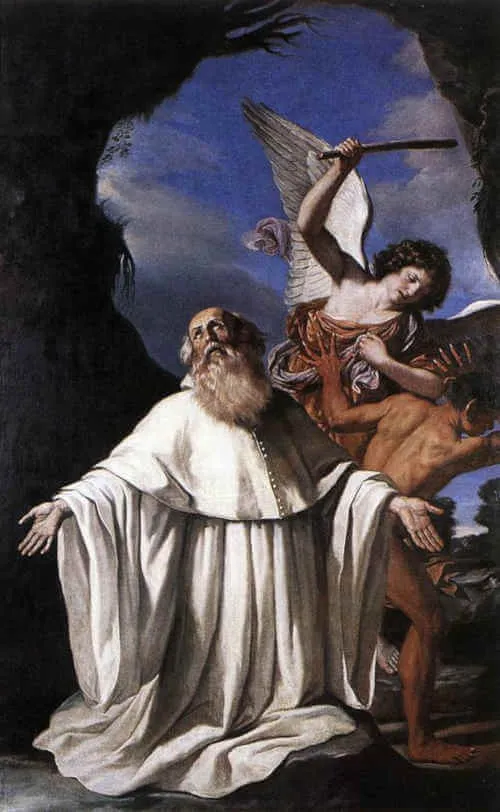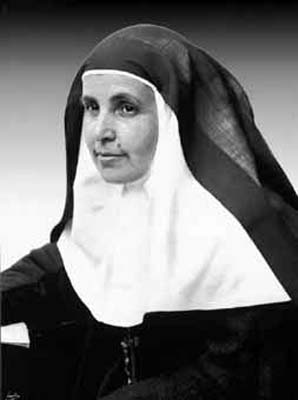c. 951–1027; Invoked for reformation of the Church and monastic life; Canonized by Pope Gregory XIII in 1582
Saint Romuald was born into a noble family in Ravenna, located in modern-day northern Italy. As a youth, he was reportedly quite mischievous, and by some accounts, even vicious. It’s likely he adopted such behavior in imitation of his father. During that time, the nobility were often engaged in conflicts over control of land, political power, or in response to perceived violations of their family’s honor. When Romuald was twenty, his father, Sergius degli Onesti, found himself embroiled in such a conflict with a relative over land ownership. They resolved their dispute through a duel, which Sergius won by killing his relative. Even though Romuald was no stranger to such conflicts, he was horrified by his father’s actions. Romuald fled to the Benedictine monastery of San Apollinare-in-Classe, just south of Ravenna. Initially, he went to the monastery for a forty-day retreat of prayer and penance to atone for his father’s sin. After forty days, however, he decided to stay and become a monk.
In Romuald’s day, many European monasteries were undergoing reform. Many had become political in nature and had relaxed their emphasis on prayer. When Romuald entered the Monastery of San Apollinare-in-Classe, reforms had just started, but true reform takes a long time. Given Romuald’s newfound zeal for prayer and penance, coupled with his temper and lack of patience, he often lashed out at his fellow monks for their lax lifestyle. As a result, Romuald was not very popular among the more worldly monks. He requested and quickly received permission from the abbot to move to Venice and live as a hermit under the spiritual direction of another hermit named Marinus. For the next several years, Romuald lived a strict life of solitude, silence, prayer, and penance. Under Marinus, he developed his own monastic lifestyle, learning not only from Marinus but also directly from the Holy Spirit through his life of prayer.
Around the year 978, while in his late twenties, Romuald and Marinus moved to the border of France and Spain and built a hermitage near the Monastery of Saint-Michel-de-Cuxa. For the next several years, Romuald continued to live a life of prayer, solitude, and silence, along with a period of intense study, taking advantage of the library at the nearby monastery. His studies, guided by the Holy Spirit, led him to further develop a new way of being a hermit and to a deeper understanding of the ideals of monasticism in general.
Around the age of thirty-seven, after living the hermit’s life for fifteen to twenty years and developing a new theological and practical understanding of the ideals of monasticism, Romuald began traveling across Europe. He founded new hermitages and monasteries and provided spiritual direction to existing ones in need of reform. One of his first stops was to visit his father, who had since repented of his former lifestyle and became a monk himself. Before his father died, Romuald helped him more fully embrace his new monastic vocation. Sometime after 996, Otto III ascended to the role of Holy Roman Emperor. Otto was devoted to reforms within the Church and across the empire. One story relates that when Otto heard about Romuald’s fervor and commitment to reforming monastic life, Otto asked him to become the abbot of Otto’s first monastery, San Apollinare-in-Classe. However, the monks resisted Romuald’s reform efforts so vehemently that he left in frustration within a year.
In 1012, according to legend, a man named Maldolus had a vision of monks dressed in white ascending a ladder to Heaven. Prompted by this vision, Maldolus donated a piece of land he owned in Camaldoli, near Arezzo in Tuscany, to Romuald. On this land, Romauld built five hermitages, marking the beginnings of the Camaldolese Hermits of Mount Corona. This new form of monasticism harmonized, for the first time, the lives of hermits and monks. Monks lived in community, sharing meals, work, and communal prayer. Hermits, in contrast, pursued their vocations mostly in solitude. Romuald’s innovative form of monasticism aimed to marry these two vocations. The monks each lived in their own hermitages in silence and solitude but would gather each day in a shared chapel for prayer. They also shared meals, though not as frequently as traditional monks, and shared a common mission and rule of life. Over the next fifteen years, Romuald founded several more monastery-hermitages, firmly establishing his new form of monastic life within the broader life of the Church.
The “Brief Rule” that Saint Romuald left his brothers is just that, brief. It is quoted above in its entirety. In its simplicity, it spells out all that Saint Romuald believed monk-hermits needed to know in order to live the life to which they are called. The Rule offers seven exercises to help grow in contemplation. The hermit-monk must love his cell, be detached, be self-observant, attentive to praying the Psalms, reverent before God, intense in asceticism, and become childlike in one’s receptivity to grace.
Saint Romuald passed away in the solitude of his cell, a place he referred to as “paradise.” Numerous miracles were reported in the years following his death by those who prayed at his tomb. According to legend, approximately 400 years later, his body was exhumed and found to be incorrupt, but being sacrilegiously unearthed, the body turned to dust. Other accounts state that his body remains incorrupt and was relocated to Fabriano, Italy, where his order had constructed another monastery. Today, this church is known as Saint Romuald’s.
The eremitical life of a hermit, while not suited for everyone, plays an essential role in the life of the Church. God calls a select number of men and women to serve as intercessors for the entire Church, as well as beacons guiding our pilgrimage toward Heaven. Their vocation underscores the importance of prayer, solitude, silence, and asceticism. As we honor the great founder of the Camaldolese Order, let us reflect on our own need for deeper interior silence, attainable only through solitude, prayer, and penance. While you might not be called to live as a hermit, you are nonetheless summoned to periods of contemplation where you can experience a glimpse of their lifestyle. Daily prayer, retreats, adoration, and the like are essential in this fast-paced and noisy world. Commit to emulating Saint Romuald and allow his witness to guide you towards a deeper union with God.
Source: https://mycatholic.life/saints/saints-of-the-liturgical-year/june-19—saint-romuald-abbot/








